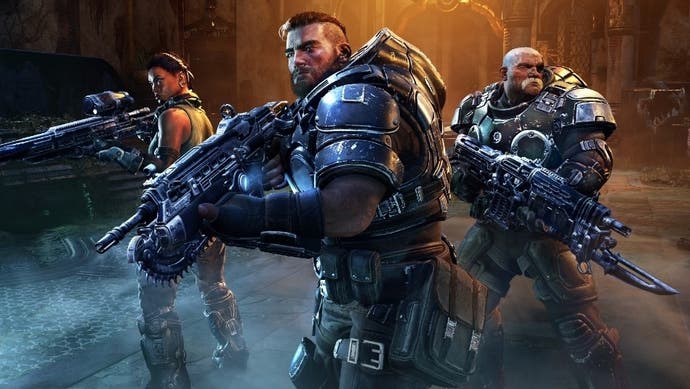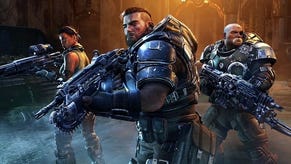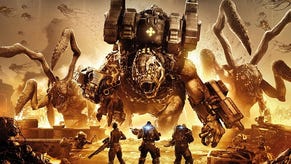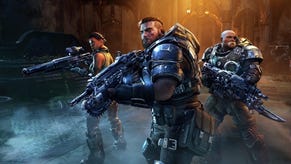Gears Tactics review - brains and brawn join forces as the fight against the Locust goes turn-based
Fenix point.
Gears of War has always been built around its cover system, with almost 15 years experience when it comes to squeezing its muscled heroes behind bits of wall, or whatever's at hand, as they exchange fire with their equally muscled, subterrestrial counterparts. Once slotted into place, it's then been up to the player to figure out how to gain the upper hand, perhaps lobbing a grenade to push enemies out of cover, or rushing forward to take advantage of an exposed flank. When described in these sorts of terms, it makes sense that the Gears series would eventually dip its considerable toes into the world of turn-based strategy, but how well does it actually translate?
Eager to answer that question for us, Tactics is very quick to reintroduce another Gears of War staple: executions. Things may be a little slower paced here, but look, you can still chainsaw people in half! Downing an enemy will occasionally see them drop to their knees, allowing one of your bulky lads to jog over and bash their head in with a pistol, or gut them with a bayonet. As a visual spectacle, I'm a little less excited about this than I might have been in 2006, but as a game mechanic, let me tell you, executions allow for some brilliant decision making. That's a very odd sentence to have typed out. Let me explain.
In Gears Tactics, each soldier in your squad has a handful of action points to spend per turn, whether that's through moving, taking shots or using abilities. Once everyone's out of actions, the bad guys get their go. It's standard stuff. Landing an execution, however, changes things. Once you've finished beating the poor Locust to death with their own limbs, your entire squad (aside from the one performing the execution) is rewarded with an additional action point. There are even times where you'll be able to chain a string of executions together and essentially double the number of actions you were meant to take that turn. This alters the game in a pretty significant way.
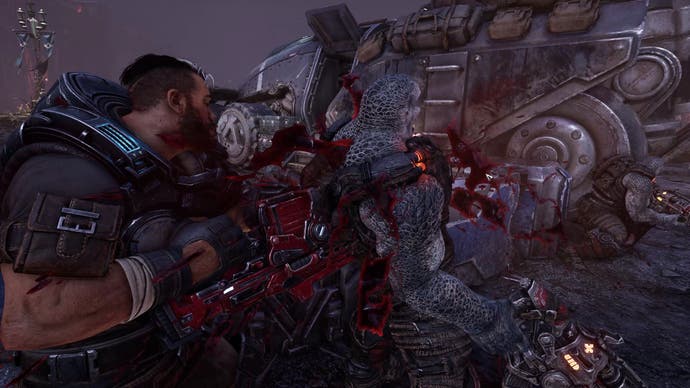
For a start, it means that Tactics is able to pit you against many more enemies than you'd typically expect. The odds are often stacked against you, quite considerably, with the hopes that you can claw your way back into control with a few well-timed decapitations. The first time this really clicked into place for me was during an early mission in which my squad was surrounded by Wretches, a fairly weak enemy type that can prove deadly when encountered in large numbers. With his last available action, Sid Redburn (one of the game's named heroes) managed to execute a nearby Drone and in doing so, gifted his squadmates a fresh round of actions. This allowed another soldier to revive a downed teammate, which proved crucial, as she was the one carrying the frag grenade that could deal with the Wretches before they descended upon my squad. What a hero!
The right execution at the right time can sometimes turn around even the most doomed situations and these moments are the game at its very best. If you've played Into The Breach (and you should, it's superb) you'll likely recognise this sensation, as you suddenly glimpse a way out of what seemed like the most impossible scenario just moments beforehand.
Aside from these Eureka-worthy executions, much of the Gears Tactics experience in combat borrows heavily from the Firaxis XCOM games. Your squad may enter the battlefield courtesy of an armoured car rather than a Skyranger, but the end result is a similar one. You'll take and miss shots, you'll use Overwatch (albeit this time with cones of vision!), you'll complete objectives and race to evacuate before being overrun. There's some fun reimagining of the Gears weapons and abilities (the bayonet charge remains a highlight, even here), but I do wish the enemy units had more to offer. Unlike XCOM, where every alien usually has a couple of different tricks up their sleeve, here, your opponents feel more limited.
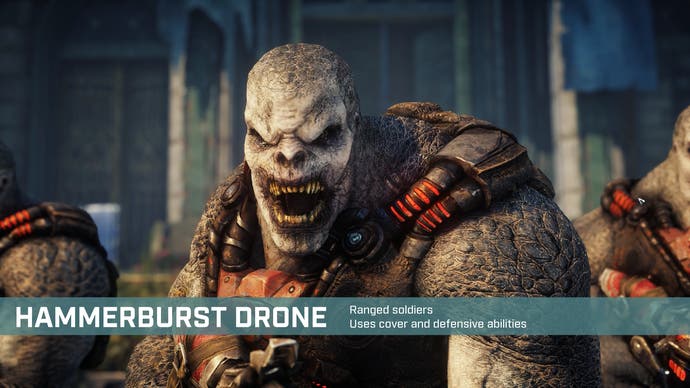
Compare the Sectoids of XCOM: Enemy Unknown with the Drones of Gears Tactics, for example. Both units can move, open fire and set up overwatch, but on top of this, XCOM's Sectoids might use suppressive fire to pin one of your soldiers in place, or merge minds with another alien, improving their stats but also exposing them to further danger. They're both units that you'll encounter frequently throughout their respective campaigns, but one is quite a bit more interesting than the other. This comparison can be felt across many of the Gears Tactics enemies, unfortunately.
The exception to that rule comes with the boss fights at the end of each Act, in which you're pitted against some of the more deadly monsters of the Gears universe. Brumaks and Corpsers, the big guns. These fights offer much more variety, with multiple attack types that'll force you to keep moving your units and scramble to new cover as you chip away at an intimidatingly large health bar. Boss fights can work in the turn-based space, says Gears Tactics, and I'm inclined to agree.
Outside of the missions themselves, Gears does drift away from the XCOM formula more substantially, opting to do away with base building, research and the strategy layer all together. Your soldiers still level up and unlock new abilities, but their weapon and equipment upgrades are found in crates that you'll need to pick up during missions, or earn as rewards for completing optional objectives. There are no microtransactions here, but these crates still carry with them the distinct feeling of loot boxes, even down to the opening animations.
Some of you may be delighted to hear that you won't need to research new weapons or hire engineers to create them for your squad, but these colour-coded crates never feel like much of a replacement. Although I appreciated the added incentive they provided to take risks during the missions themselves, opening them and sorting through all of the various weapon attachments I'd unlocked afterwards tended to feel like a chore. I never felt any real ownership over what I found inside, I suppose that's the real problem. These weren't weapons or armour I'd set out to craft, it was just another scope or rifle barrel that I'd found in a loot box, seemingly at random.
The campaign is separated into story missions that need to be completed and side missions that you're able to choose between. These side trips often present some of the more interesting setups, as they'll come with their own modifiers like +100 per cent damage from Wretches, or increased movement range for your squad. You're also limited by the fact that you can't take the same team with you for every mission as sometimes they'll need to rest, or you won't have access to a certain character for narrative reasons. This means you'll need to recruit enough units to flesh out a small roster and then switch between them as you go.
In theory, most of your soldiers should be the run-of-the-mill Gears who've been recruited along the way and as is now the norm in the world of turn-based tactics, you're able to customise these men and women to your heart's content, with different names, armour and colour schemes... only to see them die permanently should you put them in harm's way.

But in practice, it's the game's hero units that always matter the most. They have to survive for your campaign to continue (forcing you to restart missions if they die), as they're key to its storyline and you'll usually be required to bring some of them with you on most missions. This means there'll be at the very top of your priority list when it comes to which soldiers you'll want to focus on leveling up and kitting out. In fact, given that I'd also received Augustus Cole (AKA The Cole Train) as a pre-order bonus, I rarely used more than one or two non-hero units in my squad at any one time, as I felt it'd be a waste of experience points to do so. I can't help but wonder if I'd have had more fun managing my squad, mixing and matching the different classes, if there had been no 'heroes' whatsoever. At least it would have felt like a choice I was making.
As for the storyline itself, Gears Tactics is a prequel to the original Gears of War, set 12 years before anyone has decided to pull Marcus Fenix out of jail. Actually, I suppose he's not in jail yet, is he? Lucky him! You're tasked with hunting down a Locust scientist, "a monster who makes monsters", and there's some mystery to the politics surrounding this whole operation, but I found it all quite uninspired in the end. Your squad jumps between trust and distrust of one another with alarming frequency, with the end result being that none of it feels particularly genuine.
There are moments in which Tactics does manage to be the successful marriage between Gears of War and XCOM that you might have hoped for, but as a whole package, I'm not convinced it's ever quite as good as that. I applaud it for experimenting with some brand new ideas, as well as providing another solid entry point into the turn-based strategy genre for those who've not been convinced in the past. But with the likes of Enemy Unknown and XCOM 2 having paved the way before this, Tactics had some big shoes to fill and not even Sid Redburn (who looks to be a size 16, at least) could quite manage it for me. But that execution mechanic! What a fantastic idea.
